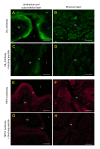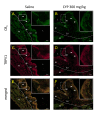Local activation of cannabinoid CB₁ receptors in the urinary bladder reduces the inflammation-induced sensitization of bladder afferents
- PMID: 21554718
- PMCID: PMC3115893
- DOI: 10.1186/1744-8069-7-31
Local activation of cannabinoid CB₁ receptors in the urinary bladder reduces the inflammation-induced sensitization of bladder afferents
Abstract
Background: Systemic administration of cannabinoid agonists is known to reduce pain induced by bladder inflammation and to modulate cystometric parameters in vivo. We have previously reported that intravesical administration of a cannabinoid agonist reduces the electrical activity of bladder afferents under normal conditions. However, the effects of local activation of bladder cannabinoid receptors on afferent activity during inflammation are unknown. This study was aimed to assess the effects of intravesical administration of a cannabinoid agonist on the discharges of afferent fibers in inflamed bladders ex vivo. We also characterized the expression of CB1 receptors in the bladder and their localization and co-expression with TRPV1, a marker of nociceptive afferents.
Results: Compared to untreated animals, afferent fiber activity in inflamed bladders was increased for intravesical pressures between 10 and 40 mmHg. Local treatment with a non selective cannabinoid agonist (AZ12646915) significantly reduced the afferent activity at intravesical pressures above 20 mmHg. This effect was blocked by AM251 but not by AM630 (selective for CB1 and CB2 respectively). Finally, CB1 was co-expressed with TRPV1 in control and inflamed bladders.
Conclusion: These results demonstrate that sensitization of bladder afferents induced by inflammation is partly suppressed by intravesical activation of cannabinoid receptors, an effect that appears to be mediated by CB1 receptors. Also, TRPV1 positive fibers were found to co-express CB1, supporting the hypothesis of a direct action of the cannabinoid agonist on nociceptive afferents. Taken together, these results indicate a peripheral modulation by the cannabinoid system of bladder hypersensitivity during inflammation.
Figures






Similar articles
-
Cannabinoid CB1 receptors are expressed in the mouse urinary bladder and their activation modulates afferent bladder activity.Neuroscience. 2009 Mar 31;159(3):1154-63. doi: 10.1016/j.neuroscience.2009.01.050. Epub 2009 Feb 3. Neuroscience. 2009. PMID: 19356696
-
CB2 cannabinoid receptor agonist selectively inhibits the mechanosensitivity of mucosal afferents in the guinea pig bladder.Am J Physiol Renal Physiol. 2021 May 1;320(5):F859-F865. doi: 10.1152/ajprenal.00065.2021. Epub 2021 Mar 22. Am J Physiol Renal Physiol. 2021. PMID: 33749323
-
A combination of peripherally restricted CB1 and CB2 cannabinoid receptor agonists reduces bladder afferent sensitisation in cystitis.Eur J Pharmacol. 2024 Dec 15;985:177078. doi: 10.1016/j.ejphar.2024.177078. Epub 2024 Nov 10. Eur J Pharmacol. 2024. PMID: 39532227
-
The pharmacology of cannabinoid receptors and their ligands: an overview.Int J Obes (Lond). 2006 Apr;30 Suppl 1:S13-8. doi: 10.1038/sj.ijo.0803272. Int J Obes (Lond). 2006. PMID: 16570099 Review.
-
Pharmacological actions of cannabinoids.Handb Exp Pharmacol. 2005;(168):1-51. doi: 10.1007/3-540-26573-2_1. Handb Exp Pharmacol. 2005. PMID: 16596770 Review.
Cited by
-
Effects of cannabinoid receptor activation by CP55,940 on normal bladder function and irritation-induced bladder overactivity in non-awake anaesthetised rats.Int Urogynecol J. 2016 Sep;27(9):1393-400. doi: 10.1007/s00192-016-2984-x. Epub 2016 Mar 4. Int Urogynecol J. 2016. PMID: 26942594
-
Cannabinoid receptor expression in the bladder is altered in detrusor overactivity.Int Urogynecol J. 2016 Jan;27(1):129-39. doi: 10.1007/s00192-015-2802-x. Epub 2015 Jul 30. Int Urogynecol J. 2016. PMID: 26224382
-
Components of the Endogenous Cannabinoid System as Potential Biomarkers for Interstitial Cystitis/Bladder Pain Syndrome.Diagnostics (Basel). 2021 Dec 23;12(1):19. doi: 10.3390/diagnostics12010019. Diagnostics (Basel). 2021. PMID: 35054185 Free PMC article. Review.
-
Cannabinoid-based drugs targeting CB1 and TRPV1, the sympathetic nervous system, and arthritis.Arthritis Res Ther. 2015 Sep 6;17(1):226. doi: 10.1186/s13075-015-0743-x. Arthritis Res Ther. 2015. PMID: 26343051 Free PMC article. Review.
-
CB1 cannabinoid receptor agonist prevents NGF-induced sensitization of TRPV1 in sensory neurons.Neurosci Lett. 2013 Sep 13;551:34-8. doi: 10.1016/j.neulet.2013.06.066. Epub 2013 Jul 12. Neurosci Lett. 2013. PMID: 23850608 Free PMC article.
References
-
- Walczak JS, Price TJ, Cervero F. Cannabinoid CB1 receptors are expressed in the mouse urinary bladder and their activation modulates afferent bladder activity. Neuroscience. 2009;159:1154–1163. - PubMed
-
- Gratzke C, Streng T, Park A, Christ G, Stief CG, Hedlund P, Andersson KE. Distribution and function of cannabinoid receptors 1 and 2 in the rat, monkey and human bladder. J Urol. 2009;181:1939–1948. - PubMed
-
- Tyagi V, Philips BJ, Su R, Smaldone MC, Erickson VL, Chancellor MB, Yoshimura N, Tyagi P. Differential expression of functional cannabinoid receptors in human bladder detrusor and urothelium. J Urol. 2009;181:1932–1938. - PubMed
Publication types
MeSH terms
Substances
Grants and funding
LinkOut - more resources
Full Text Sources
Other Literature Sources

